AEV Activities
The Agro-Ecological Village approach is a logical evolution for rural development programming that provides a more holistic and comprehensive approach for the social, ecological, and technological development of communities. It is imperative that village groups be highly engaged in participatory processes, training sessions, and advisory networks for farm improvement. Through this multi-tasking process, communities can be empowered to take ownership of their own development. In order to facilitate the transition into an Agro-Ecological Village, the three core AEV Development objectives are to:- Establish and build the capacity of farmer's organizations utilizing participatory rural appraisals, participatory monitoring and evaluation, and other processes and support gender development for all project activities;
- Train farmer trainers on ecological farming methods, establish a farmer-to-farmer training network and develop localized training modules to support the development of ecological farming systems and assist communities in the development and implementation of ecological farm plans; and
- Establish learning farms/gardens and participatory on-farm research to improve the plant material base and introduce improved plant varieties of vegetables, field crops, grasses and tree species, and develop ecological farming practices such as indigenous knowledge systems, intercropping, sustainable livestock management, agro-forestry and appropriate technologies.
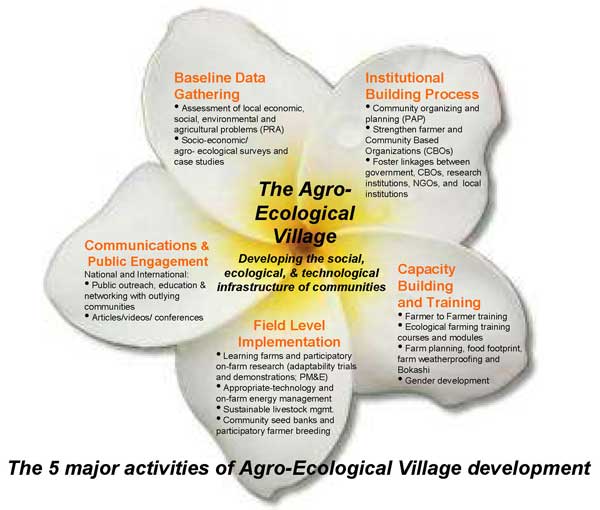
1. Baseline data gathering and surveys/case studies:
Information collected during initial site visits provides the background for measuring progress in a community and provides an initial assessment of the local situation.
 |
| Posters in local language to sensitize locals of the AEV concept |
- Participatory Rural Appraisal (PRA): To begin a more systematic understanding of the development needs of communities, a process of community self-examination can be undertaken by people with experience in group facilitation. PRA facilitators can use tools such as resource mapping, seasonal calendars, Venn diagrams, transect walks and mobility maps to deepen the beneficiaries understanding of their villages and individual farm situation and develop appropriate solutions through project activities.
- Agro-ecological and socio-economic surveys may also be collected. Data is gathered from a representative subset of households per community and includes information related to income sources, food systems, farm production, energy use, health and gender issues.
2. Institutional Building Process:
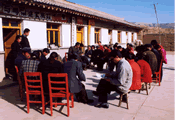 |
| Participatory monitoring and evaluation workshop with farmer trainers and community members in Gansu, China |
- Sensitization: Communities can become more aware and understanding of their local situation through a process of sensitization and exposure by community organizers.
- Participatory Action Planning & Monitoring and Evaluation (PAP and PM&E):
Participatory monitoring and evaluation workshop with farmer trainers and community members in Gansu, China Similar to conventional approaches, PAP and PM&E are used to first plan and then measure changes resulting from specific interventions. The main difference is that in a participatory approach, stakeholders who are directly or indirectly involved in a program take part in selecting the indicators to measure changes, in collecting information, and in evaluating findings. - Community Organizers: Local people with effective interpersonal skills need to organize the project beneficiaries. This may involve the investment of significant energy in the community and working with key community leaders who can collectively break apathetic attitudes that may exist.
- Strengthening Farmers' Organizations and Networks: One strategy of the Agro-Ecological Village development model is to empower and more effectively use existing farmer organizations and community groups. The main aspects of the capacity building process shall be:
- Increasing farmers' capacity through trainings using participatory approaches to analyze their local environment and apply ecological principles to their farming methods
- Institutionalize approaches of mutual learning, support and information exchange within the community (local)
- Institutionalize approaches to network information and experiences outside the community (regional and national)
Capacity building exercises aim to empower locals to take a lead role in their own development process.
- Farmer to Farmer Training: Fundamental to this approach is to develop local farmer trainers to lead training sessions. Through this participatory peer education approach, trainers and farmer students are continuously being developed, and groups are kept small as farmers are exposed to a diversity of farmer trainers and issues. Trainings are customized to local needs and evolve through on-going assessments. The basic ecological farming module includes:
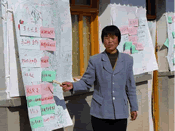
- Soil Fertility Management
- Cropping systems
- Weed management
- Pest & disease management
- Soil & water conservation
- Livestock Management
- Year-round food security
- Agro-forestry
- Perennial grasses and animal fodder
- Farm Planning: Following the introductory training in ecological farming, the farmers go through a basic farm planning process. This provides them with an opportunity to better assess their goals and objectives and to do a more systematic planning to achieve their targets. Food Footprint: This analysis is a simple and effective farm-planning tool that provides a clear representation of household food consumption. It aims to enhance food self reliance while minimizing the quantity of land required to meet household food requirements. This is helpful for smallholders in improving food security while finding ways to produce more food from a smaller land base to free up more land to be cultivated for livelihood. Farm Weatherproofing: Assisting rural communities to manage and adapt to changes in climate by adopting drought tolerant crops and varieties, improve ecological soil fertility management, using mulches to reduce evaporation from fields, and use of windbreaks. The overall goal is to improve water use efficiency and maintain relatively stable production during extreme weather events
- Gender Strategy: The AEV model engages both women and men as effectively as possible in all aspects of each project. By involving active participation in project trainings, planning and implementation, women and men are encouraged to take an active role in improving their confidence in decision making and their overall quality of life.
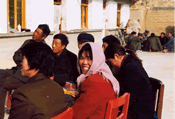 |
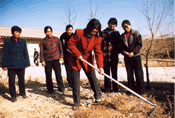 |
| Participatory Training Workshop in Gansu, China | Women demonstrating improved potato hoe that speeds hoeing and reduces labour strain |
The AEV model ensures the execution of individual farm plans, employing on-the-ground activities to increase farmers' understanding and capacities to meet their objectives.
5. Communications and Public Engagement:
Development impacts will continue to be shared with others in the development community, both in the host country and abroad, so that any lessons learned may be applied elsewhere. The general public will be made increasingly aware of the project, promoting a better understanding of North-South issues and increasing support for international development.
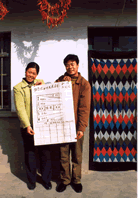 |
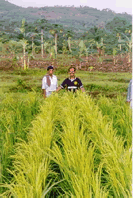 |
 |
|---|---|---|
| Developing a new farm plan can be an empowering experience | Leopoldo Guilaran of PABINHI with a new eco-rice he has developed through on-farm breeding | Success in a potato adaptability trial. Mr. Cheng and the weishu potato |
- Learn more about:
- AEV Model
- AEV in the Philippines
- AEV in China
- AEV in the Gambia




